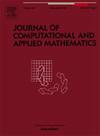An iterative method for Helmholtz boundary value problems arising in wave propagation
IF 2.1
2区 数学
Q1 MATHEMATICS, APPLIED
Journal of Computational and Applied Mathematics
Pub Date : 2025-02-22
DOI:10.1016/j.cam.2025.116581
引用次数: 0
Abstract
The complex Helmholtz equation (where ) is a mainstay of computational wave simulation. Despite its apparent simplicity, efficient numerical methods are challenging to design and, in some applications, regarded as an open problem. Two sources of difficulty are the large number of degrees of freedom and the indefiniteness of the matrices arising after discretisation. Seeking to meet them within the novel framework of probabilistic domain decomposition, we set out to rewrite the Helmholtz equation into a form amenable to the Feynman–Kac formula for elliptic boundary value problems. We consider two typical scenarios, the scattering of a plane wave and the propagation inside a cavity, and recast them as a sequence of Poisson equations. By means of stochastic arguments, we find a sufficient and simulatable condition for the convergence of the iterations. Upon discretisation a necessary condition for convergence can be derived by adding up the iterates using the harmonic series for the matrix inverse—we illustrate the procedure in the case of finite differences.
From a practical point of view, our results are ultimately of limited scope. Nonetheless, the unexpected—even paradoxical—new direction of attack on the Helmholtz equation proposed by this work offers a fresh perspective on this classical and difficult problem. Our results show that there indeed exists a predictable range in which this new ansatz works, with being far below the challenging situation.
波传播中亥姆霍兹边值问题的迭代解法
复亥姆霍兹方程(Δ+k2)u=f(其中k∈R,u(⋅),f(⋅)∈)是计算波模拟的支柱。尽管表面上很简单,但有效的数值方法在设计上具有挑战性,在某些应用中被视为一个开放的问题。困难的两个来源是大量的自由度和离散化后产生的矩阵的不确定性。为了在概率域分解的新框架内满足它们,我们着手将亥姆霍兹方程改写为适用于椭圆边值问题的费曼-卡茨公式的形式。我们考虑了两种典型的情形,平面波的散射和在腔内的传播,并将它们重新刻写为泊松方程序列。利用随机参数,得到了迭代收敛的充分且可模拟的条件。在离散化之后,可以通过使用矩阵逆的调和级数将迭代相加得到收敛的必要条件——我们举例说明在有限差分情况下的过程。从实际的角度来看,我们的结果最终是有限的。尽管如此,这项工作提出的对亥姆霍兹方程的意想不到的——甚至是矛盾的——新的攻击方向,为这个经典而困难的问题提供了一个新的视角。我们的结果表明,确实存在一个可预测的范围k<;kmax,在这个范围内,这种新的分析方法是有效的,kmax远远低于具有挑战性的情况。
本文章由计算机程序翻译,如有差异,请以英文原文为准。
求助全文
约1分钟内获得全文
求助全文
来源期刊
CiteScore
5.40
自引率
4.20%
发文量
437
审稿时长
3.0 months
期刊介绍:
The Journal of Computational and Applied Mathematics publishes original papers of high scientific value in all areas of computational and applied mathematics. The main interest of the Journal is in papers that describe and analyze new computational techniques for solving scientific or engineering problems. Also the improved analysis, including the effectiveness and applicability, of existing methods and algorithms is of importance. The computational efficiency (e.g. the convergence, stability, accuracy, ...) should be proved and illustrated by nontrivial numerical examples. Papers describing only variants of existing methods, without adding significant new computational properties are not of interest.
The audience consists of: applied mathematicians, numerical analysts, computational scientists and engineers.

 求助内容:
求助内容: 应助结果提醒方式:
应助结果提醒方式:


